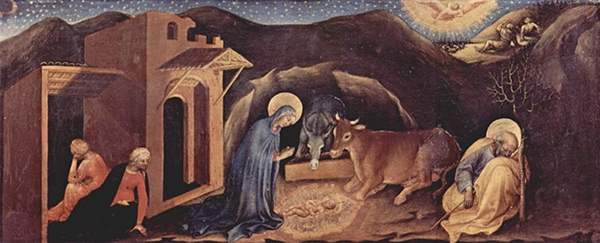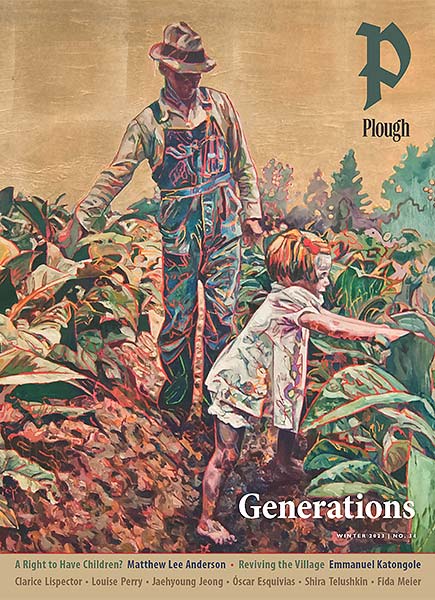Subtotal: $
Checkout
Jesus was born in a stable, a real stable, not the bright, airy portico which Christian painters have created for the Son of David, as if ashamed that their God should have lain down in poverty and dirt. And not the modern Christmas Eve “holy stable” either, made of plaster of Paris, with little candy-like statuettes, the holy stable clean and prettily painted with a neat, tidy manger, an ecstatic ass, a contrite ox, and angels fluttering their wreaths on the roof – this is not the stable where Jesus was born.
A real stable is the house, the prison of the animals who work for man. The poor, old stable of Christ’s old, poor country is only four rough walls, a dirty pavement, a roof of beams and slate. It is dark, reeking. The only clean thing in it is the manger where the owner piles the hay and fodder.
Fresh in the clear morning, waving in the wind, sunny, lush, sweet-scented, the spring meadow was mown. The green grass, the long, slim blades, were cut down by the scythe; and with the grass the beautiful flowers in full bloom – white, red, yellow, blue. They withered and dried and took on the one dull color of hay. Oxen dragged back to the barn the dead plunder of May and June. And now that grass has become dry hay and those flowers, still smelling sweet, are there in the manger to feed the slaves of man. The animals take it slowly with their great black lips, and later the flowering fields, changed into moist dung, return to light on the litter which serves as bedding.

Gentile da Fabriano, Adoration of the Magi (detail)
This is the real stable where Jesus was born. The filthiest place in the world was the first room of the only pure man ever born of woman. The Son of Man, who was to be devoured by wild beasts calling themselves men, had as his first cradle the manger where the animals chewed the cud of the miraculous flowers of spring.
It was not by chance that Christ was born in a stable. What is the world but an immense stable where men produce filth and wallow in it? Do they not daily change the most beautiful, the purest, the most divine things into excrement? Then, stretching themselves at full length on the piles of manure, they say they are “enjoying life.” Upon this earthly pig-sty, where no decorations or perfumes can hide the odor of filth, Jesus appeared one night, born of a stainless Virgin armed only with innocence. . . .
First to worship Jesus were animals, not men. Among men he sought out the simple-hearted: among the simple-hearted he sought out children. Simpler than children, and milder, the beasts of burden welcomed him.
Though humble, though servants of beings weaker and fiercer than they, the ass and the ox had seen multitudes kneeling before them. Christ’s own people, the people of Jehovah, the chosen people whom Jehovah had freed from Egyptian slavery, when their leader left them alone in the desert to go up and talk with the Eternal, did they not force Aaron to make them a golden calf to worship? In Greece the ass was sacred to Ares, to Dionysius, to Hyperborean Apollo. Balaam’s ass, wiser than the prophet, saved him by speaking. Oxus, King of Persia, put an ass in the temple of Ptha, and had it worshiped. And Augustus, Christ’s temporal sovereign, had set up in the temple the brazen statue of an ass, to commemorate the good omen of his meeting on the eve of Actium an ass named “the Victorious.”
Up to that time the kings of the earth and the populace craving material things had bowed before oxen and asses. But Jesus did not come into the world to reign over the earth, nor to love material things. He was to bring to an end the bowing down before beasts, the weakness of Aaron, the superstition of Augustus. The beasts of Jerusalem will murder him, but in the meantime the beasts of Bethlehem warm him with their breath. In later years, when Jesus went up to the city of death for the Feast of the Passover, he was mounted on an ass. But he was a greater prophet than Balaam, coming not to save the Jews alone but all men: and he did not turn back from his path, no, not though all the mules of Jerusalem brayed against him.
From Watch for the Light: Readings for Advent and Christmas.
Already a subscriber? Sign in
Try 3 months of unlimited access. Start your FREE TRIAL today. Cancel anytime.






Maria Watson
Baby Jesus cuddled in swaddling clothes? How could the stable be filthy? I think that mother would have had everything perfect as could be under those circumstances. Humility comes in the greatest of ease.
Ed Pell PhD
All In the past people lived in the same room with their animals. A stable is not filthy. The warmth of the animals helped keep the people warm. Let us have world wide economic justice so that people need not starve, need not have the disparity of mansions and stables. Merry Christmas